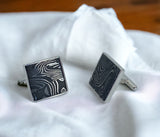Damascus and Iron Meteorite Cufflinks I 925 Silver - Meteorite Jewelry
On Offer: Set of Meteorite Damascus cufflinks in Sterling Silver
Approximate Dimensions of square: 17.3 mm x 17.3 mm
Meteorite Type: Iron
Meteorite Name: Gibeon
Found: Namibia
Year Found: 1836
Description: Beautiful set of two Gibeon meteorite damascus square cufflinks in Sterling Silver. This damascus was made out of a mix of Carbon steel and Iron meteorite. It contains 40 % Gibeon Iron meteorite and High Carbon tool steel.
What you get: Set of two Gibeon Iron meteorite damascus cufflinks from the mix of Iron meteorite and Carbon Steel set in Sterling Silver as shown, shipping/storage membrane box and signed Certificate of Authenticity.
I offer a 100% no questions asked 30 day return policy.
SEE OFFICIAL METEORITICAL SOCIETY ENTRY BELOW
| Gibeon | |||||||||||||||||
|---|---|---|---|---|---|---|---|---|---|---|---|---|---|---|---|---|---|
| Basic information |
Name: Gibeon This is an OFFICIAL meteorite name. Abbreviation: There is no official abbreviation for this meteorite. Observed fall: No Year found: 1836 Country: Namibia Mass: 26 t |
||||||||||||||||
| Classification history: |
This is 1 of 80 approved meteorites (plus 1 unapproved name) classified as Iron, IVA. [show all] Search for other: Iron meteorites, IVA irons, and Metal-rich meteorites |
||||||||||||||||
| Writeup |
Writeup from MB 36: [Description of paired specimen:] DISCOVERY OF NICO IRON METEORITE, SOUTH WEST AFRICA Name: NICO. The place of fall or discovery: The farm of Nico near the railroad station of Asab, South West Africa; φ = 25°23' S, λ = 17°47" E. Date of fall or discovery: FOUND, 1965. Class and type: IRON. Number of individual specimens: 1. Total weight: 25.2 kg and 9.5 kg <iron-shale>. Circumstances of the fall or discovery: The meteorite was found by the aborigens probably on the site of the fall. Source: Report of Dr. J. Zabringer (Heidelberg, Germany) in a letter, March 1, 1966. |
||||||||||||||||
We Also Recommend









